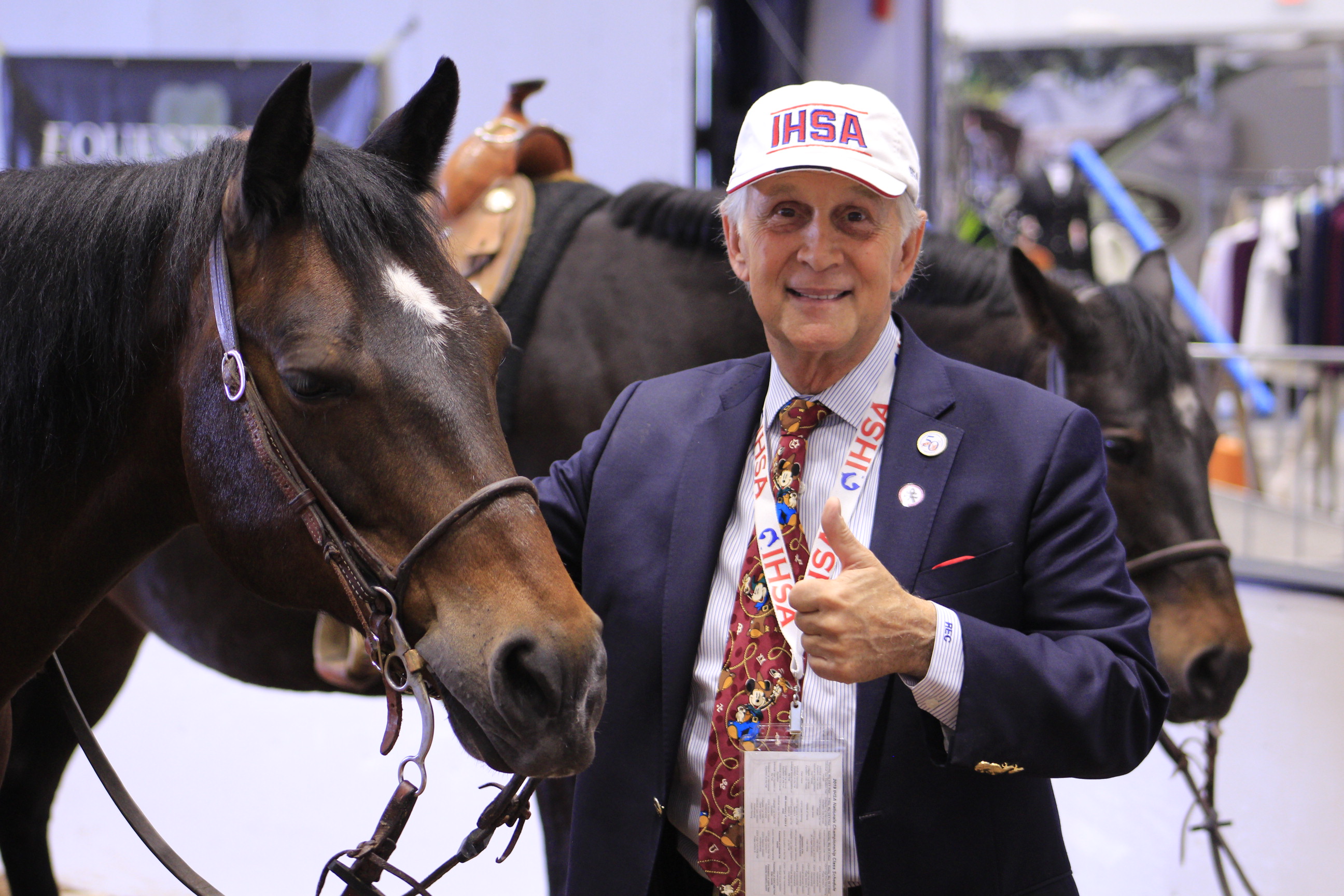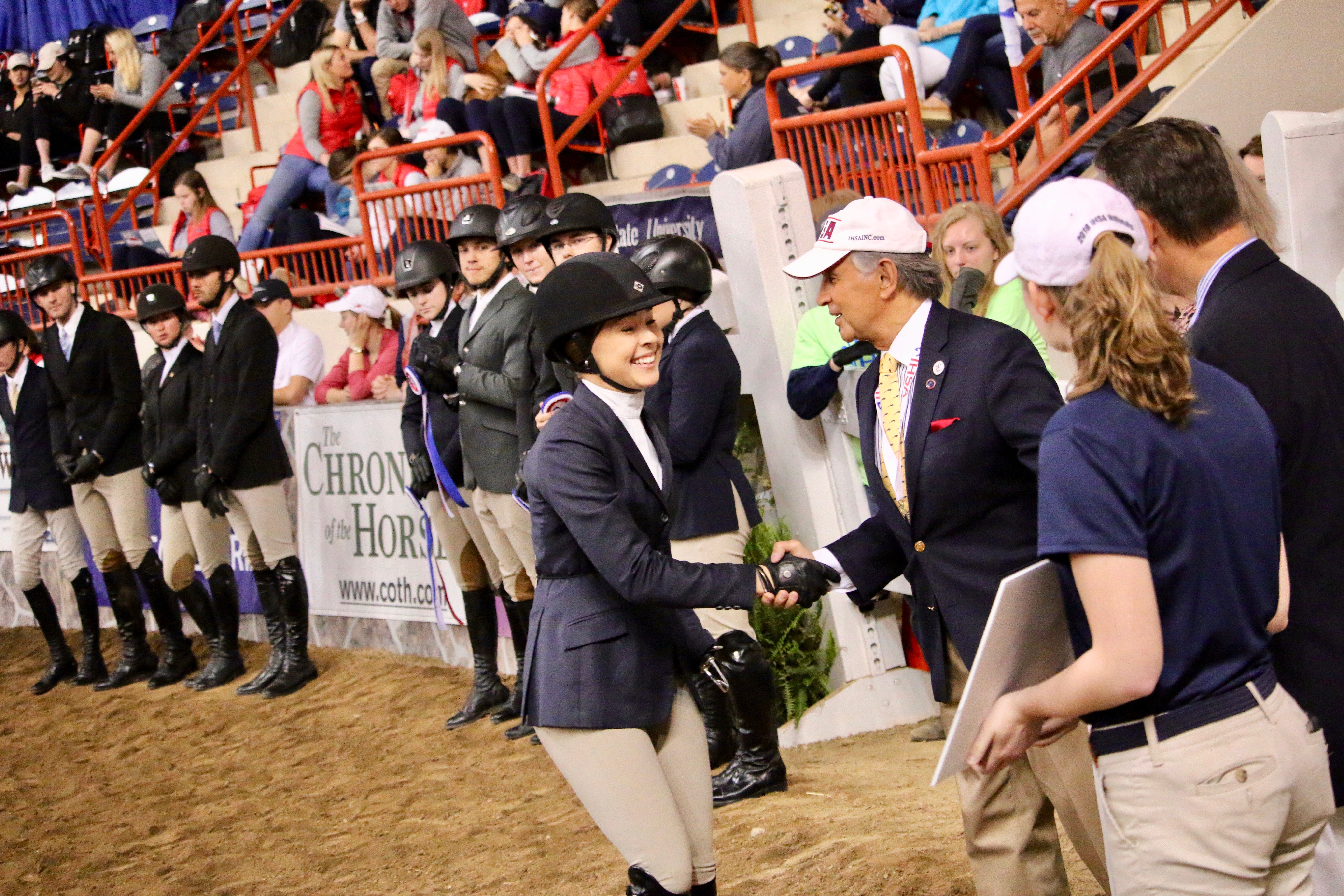Founded by Bob Cacchione in 1967 when he was a sophomore at Farleigh Dickinson University in Teaneck, New Jersey, the Intercollegiate Horse Shows Association’s goal is to give college students the opportunity to participate in equestrian competition regardless of financial status or riding level. The organization welcomes beginners through advanced riders in hunter-seat equitation, Western horsemanship and reining. These riders can compete both individually and on a team.
With more than 400 colleges that participate and more than 10,000 members, the IHSA eliminates the expenses of horse ownership. Horses for the local, regional and zone competitions as well as the IHSA National Championship are furnished by host colleges. To ensure fairness, at each competition, students draw to find out the horses they will be riding, and they are not allowed to school the horses ahead of their rides—the ultimate catch-riding experience .
Bob, the IHSA executive director, Peter Cashman, the IHSA first vice president, and I spoke at the AETA trade show last summer and covered the basics of the IHSA—it’s mission, how Bob started it, how it works. We also talk about the educational and life experience the IHSA provides as well as the camaraderie between students and colleges.

To fill you in on their background, Bob has been recognized for his commitment to college riding with the USHJA Presidents Distinguished Service Award, the US Equestrian/EQUUS Foundation Humanitarian Award, a Doctor of Humane Letters from Centenary College and the American Horse Publications Equine Industry Vision Award.
Peter Cashman is the IHSA’s First Vice President. He has been with the West Point Cadet intercollegiate team at the U.S. Military Academy in New York for 30 years and serves as the stable manager. He also coaches the team with his wife, Sherry, who wrote a training article on strengthening your base of support for Practical Horseman magazine a few years ago.
Below are some excerpts from the podcast, which aired, Friday, October 25, 2019.
Q: How does a student join an IHSA organization at school?
Bob Cacchione: You come to college, maybe you rode in camp when you were 10 years old and never rode again, and you find out there’s an equestrian team at the school. You can go there and join and be part of it, and there’s a place for you. It works. It becomes a team camaraderie. These kids work with each other, also. Many times I go to these shows and I see the Open riders are finished riding, and they take their jackets off, roll up their sleeves and they’re helping the Walk–Trot, Walk–Trot–Canter and Novice kids with their organization, getting on, helping them get into the ring. So it’s a great team camaraderie and work to make it happen for everybody.

Peter Cashman: Not every college program is the same. Your obligation when you select your college that you want to go to, you need go to the stable, meet the coach, ask him how that region runs, ask him what your opportunities will be to show, how many children are on the team, how many lessons you’ll be required to take. So as a student going to college, you have an obligation to not only find out about the college academic side but what the riding programs have to offer and make sure everything fits because this is a very formative four years of your life, and as Bob stated, the riding aspect is so important because it gives you that instant group of friends so you’re not alone. A lot of you will be going to college and it’s your first time away from home and to have that instant group of people who are like-minded really will carry the day for you.
Q: How are the horses are selected?
Bob: We bring in a little over 150 horses … and that’s between English and Western, and they are reviewed by a review committee. The hunt seat has a group and the Western has a group. So they are classified themselves, the horse. We have 16 like Walk–Trot horses and 16 like Novice horses and etc., etc. So that’s a whole program in itself. You want that similarity at Nationals so no one has an advantage or disadvantage there.

Q: Can you talk about how much time the rider has to prepare the horse for competition?
Peter: Simple answer: There’s none. You’re technically by the rules not allowed to really make contact with your horse’s face outside the ring. When you get on that horse, someone else has schooled it, so it’s not like you’re getting on an unknown. You go to the horse show and in the morning, there’s a schooling period. You need to be with your coach up at the ring, watching that horse get schooled, and it’s normally another IHSA rider who just graduated or who’s not riding that day who’s schooling the horse. So you’re seeing a like-type rider as yourself and you’re watching how that horse approaches jumps and what leg they need, what leg they don’t need. Is a crop appropriate? [That’s] your obligation as the catch rider so you can figure out from them so when you get on that horse in the warm-up area, you walk right into that ring and that’s when you make a connection with your horse. You do an opening circle and you approach your first fence.
Learning to be a team player:
Peter: That’s where you have to think differently when you ride for a team. “Do I go for all the glory? Is that appropriate at this juncture or do I get points? What do I do?” It’s a whole different concept of riding because it’s not just “Oh, heck, I’ll go hell bent for leather and if I don’t win, so what?” That’s fine when you’re in an individual class but when you’re working as a team rider and your points really matter—four points are going to win the show as opposed for the seven points for the [class] win, do you be safe and take the bigger turn and go in there and ride? … for the average horse-back rider, that’s a new theory that they haven’t thought about.

Q: Why do you do this?
Bob: This isn’t what I do. This is who I am and it always will be.
Peter: The rewards far outweigh the effort. For myself, I have Army officers who are five and six year graduated who email me and say, “You know Peter, I finally got the things you were talking about.” It’s not just about the horse-back riding. It’s the life lessons and helping them grow and be who they can be.
Bob: I’m proud to see these graduates out there now, many in the industry. Going forward maybe they’re not teaching, but there are so many things in this industry that they could be doing, and they are. I’m proud to see that. And it has opened doors for many of the riders once they graduate with the team camaraderie and the IHSA.
Thanks to the sponsor of this episode, Cosequin, makers of Cosequin Original, Cosequin Optimized with MSM, Cosequin ASU, and Cosequin ASU Plus. Cosequin’s $10 rebate on ASU and ASU Plus large tubs gives you back an extra $10 on their most advanced formulas. Learn more at CosequinEquine.com.
Visit Cosequin on Facebook and Instagram.
About the Practical Horseman Podcast
The Practical Horseman podcast, which runs every other Friday, features conversations with respected riders, industry leaders and horse-care experts to inform, educate and inspire. It is co-hosted by Practical Horseman editors Sandy Oliynyk and Jocelyn Pierce. Future podcasts are with top groom Liv Gude and Pan American Games gold medalist Boyd Martin. Find the podcast at iTunes, Stitcher and Soundcloud or wherever you get your podcasts.






